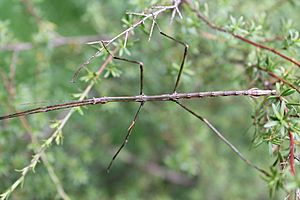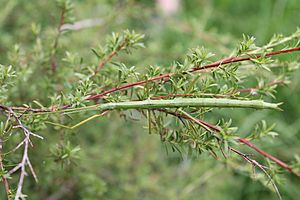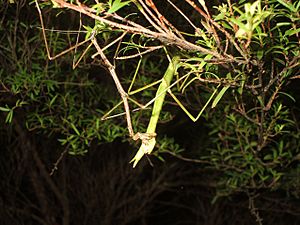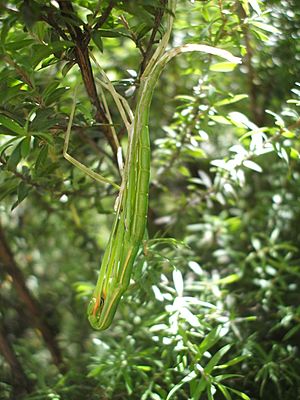Clitarchus hookeri facts for kids
Quick facts for kids Clitarchus hookeri |
|
|---|---|
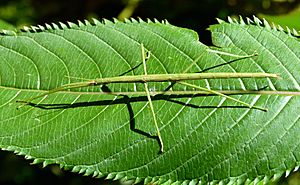 |
|
| Scientific classification | |
| Genus: |
Clitarchus
|
| Species: |
hookeri
|
The Clitarchus hookeri, also known as the New Zealand stick insect, is a fascinating insect from the family Phasmatidae. It lives only in New Zealand and is probably the most common stick insect there. These cool insects are often green, but you can also find them in brown or red colors. Along with the prickly stick insect and the unarmed stick insect, C. hookeri is one of three New Zealand stick insect species that have also made their home in Great Britain.
Contents
What Does It Look Like?
Clitarchus hookeri is a large stick insect. Males and females look a bit different in size. This is called sexual dimorphism. Female stick insects grow to be about 81 to 106 millimeters long. Males are a bit smaller, usually 67 to 74 millimeters long.
Their color can change a lot, even in the same area. They can be bright green, grey, brown, or a light tan color. Unlike many stick insects you might see in tropical places, Clitarchus hookeri cannot fly.
Where Do They Live?
You can find Clitarchus hookeri all over the North Island of New Zealand. They live from Northland down to the Wellington area. On the South Island, they are not as common. They mostly live in eastern coastal areas. This includes places like Nelson, Marlborough, and Canterbury, all the way down to Dunedin.
They have also been introduced to Great Britain. The stick insects in the UK are all female. They came from a population in Taranaki, New Zealand, where both males and females exist. These stick insects are most often found on manuka trees. But they also like to eat leaves from kanuka, pohutukawa, Muehlenbeckia australis, roses, white rata, and Coprosma plants.
Life Cycle and How They Mate
Clitarchus hookeri insects grow in a special way. They are hemimetabolous. This means their young, called nymphs, look like small versions of the adults. They grow through six stages, shedding their skin each time. After their last skin-shed, they become full-grown adults.
You can usually find adult stick insects during the summer. They are mostly active at night. During the day, they hide among the branches of their favorite trees. When the sun sets, they come out to eat and find mates. Female stick insects hang from branches, munching on leaves. They also release special smells to attract males. The males have long legs and move around at night looking for females.
Interestingly, in some places, female Clitarchus hookeri can lay eggs without needing a male. This is called parthenogenesis. In the South Island of New Zealand, males are very rare or not found at all. But in the North Island, you can find both populations that reproduce with males and those that don't.
Even though females that reproduce without a male lay about the same number of eggs, their eggs take longer to hatch. Eggs from females that didn't mate took about 21 to 23 weeks to hatch. Eggs from mated females hatched much faster, in about 9 to 16 weeks.
Where Did They Come From?
The Clitarchus hookeri stick insect is found all over New Zealand, except for the West Coast of the South Island. Scientists think that during the last Ice Age, these stick insects only lived in a few safe places. These places were in the northern North Island and on the east coast of the South Island. After the ice melted, the female stick insects that could reproduce without a male were able to spread out and live in new areas more easily.
Stick insects from the South Island and the southern North Island are very similar genetically. This means they don't have much genetic variety. But those from the upper North Island have much more genetic diversity. Scientists believe this is because the populations in the lower North Island and South Island are newer.


